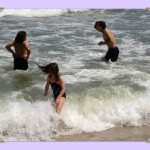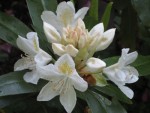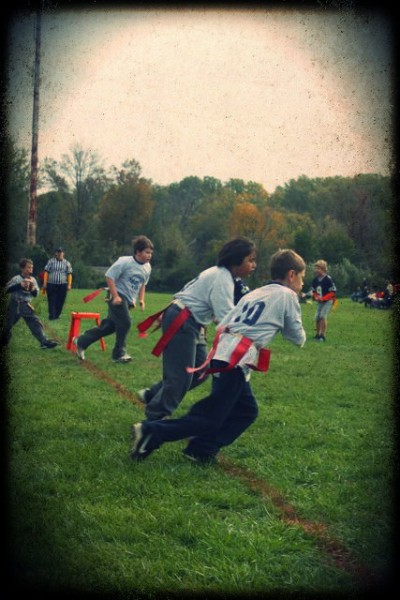Teaching children about the natural world should be treated as one of the most important events of their lives.
-Thomas Berry
In his book Last Child in the Woods: Saving Our Children From Nature-Deficit Disorder Richard Louv links the troubling trends in childhood obesity, diabetes, attention-deficit disorders, and depression, to the increasing disconnect between children and nature.
The most obvious culprit is “screen time”: TV, computer, video games.
But there are other factors, too. Even I, hippie-dippie earth mother that I try to be, am guilty of some of these:
- Fear of the Bogeyman. Our property is bordered on one side by a crumbling, never-used side street that ends in a huge field. This field is part of a state nature preserve and hiking trails lead off it, eventually ending in a creek. Not only do I not allow my older children to travel down this road, but I don’t even go down it alone. No matter how unlikely it is that any of us would be attacked or abducted- and it is, statistically, extremely unlikely- I can’t walk down this road without a feeling of trepidation, mentally framing tomorrow’s headlines.
- Fear of accidental, self-inflicted harm. My husband is the guilty party here: I know that as a child he must have built things, wielded nails and hammers, climbed trees. This is directly responsible for his hands-on abilities today, his creative instinct in practical endeavors, his “out-of-the-box” thinking. And he knows that. But he is convinced the children are going to going to require a trip to the emergency room, if he leaves them to their own devices for even a moment. He lives in mortal fear that they will get hurt. He rarely allows the kids to do things with their own hands, and if they do, he watches over them like a hawk. A nervous, bossy, stifling hawk.
- Fear of nature. “Don’t go in the woodpile- there’s probably snakes and god knows what else.” “Careful you don’t get stung.” “Don’t touch any plants you can’t identify, it’s probably poison ivy.” If we issue too many warnings, the kids will just give up and go inside. Nature will seem just too dangerous and not worth the trouble.
- Lack of solitude. Kids need solitary time, time to immerse themselves in the world around them, to identify their place in it. They need peaceful, unbroken quiet, to develop confidence in themselves, a strong inner voice, a real sense of who they are. Louv points out that many of history’s greatest thinkers, creators, and inventors relate a specific and vivid incident from their childhood, wherein they experienced a solitary moment in nature that took on a spiritual aspect; a moment of clarity. This moment serves a vital purpose; it is a cause for future reflection and motivation, a touchstone to youthful optimism and wonder. (My moment, by the way, was feeding squirrels at the bus stop, something I did all the time, when suddenly one sat up on his hind legs and started to chatter and scold at me. I could not have been more shocked if it had produced a pocketwatch and done the macarena. If squirrels talk, I wondered, what else do I not know about?) I tend to send my kids out as a team, figuring there is safety in numbers. They probably could use more time alone. I do not want to have their moment of zen stolen from them.
- Lack of trust. Louv recounts a Ben Franklin story, where young Ben steals stones from a local quarry after the workers have left for the day. He is constructing a jetty for people to fish from, and when caught, argues that he is performing a civic service. His father, after having him return the ill-gotten goods and apologize, explains that honesty is the real civic service in this situation….Over the weekend we passed a large, open lumberyard. My husband remarked that “This must be where all the local kids steal their wood for treehouses.” Somehow, I doubt it. We don’t let our kids out of our sight, partly because we fear this very sort of heathenism. But, we cannot argue that Ben Franklin learned an important lesson that day about stealing, honesty, and personal responsibility. By not allowing our children the room to make mistakes- even illegal ones- are we depriving them of lessons learned? To frame it another way, if we do not allow them the chance to violate our trust, do we form them into future citizens worthy of trust? Are we making clockwork oranges of our children?
- An overemphasis on nature as an “other”, something distant and apart. Yes, we want our children to save the earth. We want them to help polar bears and save the rainforest. But what about the right here and the right now? Are we causing nature to take on an abstract form in their minds? Does the concept become too large for them to see?
This last one is the “big thing”, I think, for me. This is my call to action. This is something I can do, actively; in fact, have already begun. I can bring about personal intimacy with our immediate environment. I will work on the other points, too, but this is the one that has me rubbing my hands together. Goodie, a project.
Louv worries about the abilities of future generations to see problems in the environment as they occur; if no children are skimming ponds for tadpoles, how will they know when those numbers begin dropping? If they are not learning to identify and name insects and wildflowers, will they notice when they are gone? If they are not outside at night to hear the spring peepers, who will sound the alarm when the night air is silent?
“[What is the] extinction of a condor
to a child who has never seen a wren?”
-Robert Michael Pyle
Yes. I will take my kids out-of-doors. Together we will “name all the animals”.
“Humans seldom value what they cannot name.”
-Elaine Brooks
This is my pledge: We will become backyard naturalists. We will look for, identify, and record everything our backyard wilderness contains. We will share, with exuberance, everything that we learn. When we have become satisfied that we know our property, we will move on to the nature preserve. To the river. To the watershed. Who knows how far we can go?
Love for the Earth first means love for the earth. The small and the familiar.
“Though it’s a small area, just a square mile or two, it took me many trips to even start to learn its secrets. Here there are blueberries, and here there are bigger blueberries…You pass a hundred different plants along the trail- I know maybe twenty of them. One could spend a lifetime learning a small range of mountains, and once upon a time people did.”
-Bill McKibben, in The Age of Missing Information
“To quote the words of Professor Abraham Joshua Heschel…our goal should be to live life in radical amazement…Everything is phenomenal; everything is incredible; never treat life casually. To be spiritual is to be amazed.”
-Rabbi Martin Levin
P.S. In a really bizarre instance of blogosphere serendipity, as I was casting about trying to find a good photo to accompany this review, my husband walked in and said that a toad was hopping around him outside, did I want to show the kids? And take a picture? What, you mean just like the cover of the book? Sure I do. Thank you, blogosphere.
Please note: All quotes in this post come via Last Child in the Woods, not from my personal stash.
I still have lots to say on this subject, so stay tuned! If you are a parent, truly you need to read this book. Twice.
More information about Richard Louv and the movement his book has inspired, No Child Left Inside, can be located at the Child & Nature Network.
Book #1 of the Still a Bookworm Challenge for Green Bean Dreams: Done. Next up: Rachel Carson’s Silent Spring.
Maverick is reading the companion book to Last Child in the Woods, entitled I Love Dirt!: 52 Activities to Help You and Your Kids Discover the Wonders of Nature . I’ll have him let you know what he thinks. The book is meant for adults, but, whatever, the kid likes to read.
Finally, I cannot at present name or identify this toad, but I will let you know when I do.












Great review! I can't wait to read your review for Root & Sprout! That book sounds fantastic!
(Oh, great pic with this post — by the way!)
I stumbled upon your blog. Wonderful!
I would like to add that I have discovered that kids are blasted daily with media's inflated sensationalism; "Deadly Predators" "Killer Snakes" "Man-Eaters" "Shark Attack!". It seems that programming on so called nature channels are named and developed to capture ratings and not deliver an important message about the need for and understanding of all animals on the planet. I am always trying to undo this misconception with my high school biology students! They think that all predators or animals with venom should be killed off. And most surprisingly – that they are NOT animals themselves.
I have just read the book and am filled with so much passion of sharing it that I do not know where to start. What a great review you have done! Thanks for sharing – and I too love the frog. 🙂
I really enjoyed reading your summary and your take on it. I have just finished rereading Last Child in the Woods so it is all very much in my mind at the moment.
Love this post. I wrote one similar a while ago. Hope your passion keeps driving you to make the effort!
You make a lot of good points on this blog. Keep up the great work.
I would like to add that I have discovered that kids are blasted daily with media's inflated sensationalism; "Deadly Predators" "Killer Snakes" "Man-Eaters" "Shark Attack!". It seems that programming on so called nature channels are named and developed to capture ratings and not deliver an important message about the need for and understanding of all animals on the planet. I am always trying to undo this misconception with my high school biology students! They think that all predators or animals with venom should be killed off. And most surprisingly – that they are NOT animals themselves.
+1
I haven’t read the book, but I remember many days as a young ‘naturalist’. Nature was and is fascinating and doesn’t take much encouragement to explore from Mom and Dad. I do think the fear of strangers does curtail the release of children into the wild. I can’t imagine letting my son (who is only 2.5 right now) roam the woods like my parents allowed my brothers and me. Human predators are much scarier than animals any day! But we have several magnifying glasses, bug jars, books on native species (of our state) and I’m trying to find native flora and fauna books. We collect leaves and rocks and the ladybugs who are now migrating inside from the farmer’s fields (non-native biting ladybugs)are creating much interest during playdates 🙂